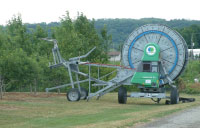
Features
Fruit
Production
Water management a growing issue in B.C.
a growing issue in B.C.
April 23, 2008 By Peter Mitham
Water management is one of the
most important issues facing agriculture these days, with some
municipalities implementing metering programs and others seeking ways
to replenish once bountiful supplies of water.
 |
| Overhead sprinkler systems are generally less efficient than drip, says Andrew Pedersen, an irrigation specialist with the B.C. Ministry of Agriculture and Lands. It takes 3.3 inches of water to deliver 2.4 inches of water to the soil in an overhead system compared to 2.7 inches of water in a drip system. Photo by Margaret Land |
Water management is one of the most important issues facing agriculture these days, with some municipalities implementing metering programs and others seeking ways to replenish once bountiful supplies of water.
Andrew Pedersen, an irrigation specialist with the B.C. Ministry of Agriculture and Lands, believes growers will come under increasing scrutiny as a result, especially since they’re typically among the most prominent water users in their communities.
Speaking in a workshop at the annual B.C. Fruit Growers Association Horticultural Forum in Penticton last November, Pedersen said growing competition for water resources will require that growers know how to effectively manage the water available to them. A good irrigation system is a good start.
One of the key points to keep in mind is what irrigation does, Pedersen told growers. Despite what some growers might think, irrigation isn’t an exercise that benefits the crop; rather it is practised for the benefit of the soil.
“We irrigate to replenish soil moisture,” he said.
Since different soil types will require different amounts of moisture – depending on how well they hold water (and local climate) – growers should know what soil types are in their orchards. Clay soils will require 2.4 inches of water for every foot of soil, for example, while a sandy loam soil typically requires 1.5 inches of water for every foot of soil.
But just how many feet should growers take into consideration? That depends on the depth of the tree’s roots. Apple trees typically have four-foot roots, Pedersen said, suggesting they require six inches of water. But they utilize just 40 per cent of soil moisture. A quick calculation indicates that water is needed for every 2.4 inches of water taken up by the tree.
The rate of absorption varies by locale but it will determine how frequently irrigation must occur, Pedersen explained. The key figure to watch is the rate of evapotranspiration, which at the Summerland branch of the Pacific Agri-Food Research Centre (PARC) peaks at about 0.28 inches a day. The Okanagan Valley as a whole typically sees evapotranspiration levels ranging anywhere from 0.23 to 0.30 inches a day.
Dividing the tree’s water requirement by evapotranspiration levels, Pedersen estimates that a tree at Summerland should be irrigated once every 8.5 days.
The irrigation system growers choose to deliver that water should not only be able to handle the water required for the orchard but be efficient, so that water costs are kept low and the resource isn’t squandered.
Pedersen suggests that growers contact a Certified Irrigation Designer to devise an appropriate system or ensure that what they have is a good fit for their site (a directory of CIDs is available online at the Irrigation Association website, www.irrigation.org; provincial associations for irrigation specialists may exist, too).
A designer will take several factors into account, including:
• position – an irrigation system across a slope will be more efficient than one going up and down, as it ensures an even distribution of water pressure;
• pipe size – the proper size of pipes will ensure an adequate flow of water and the steady operation of the system;
• automation – are there particular controls that could enhance the efficiency of the system, and how could these be set up to limit the grower’s workload.
A drip system is typically the most efficient for orchards, Pedersen told growers, working at 90 per cent efficiency and requiring just 2.7 inches of water to deliver 2.4 inches to the soil. That compares to a requirement of 3.3 inches of water from a standard overhead sprinkler system.
However, neither system will distribute the water in an efficient manner if they’re leaking. Since irrigation costs a lot, Pedersen told growers to monitor their systems to identify leaks that could boost water bills substantially.
“Walking your system while it’s operating is a very, very good plan,” he said.
Growers seeking tips on the proper scheduling of irrigation to maximize the benefit to the orchard (and reduce water costs) should consult www.FarmWest.com , Pedersen added.
Print this page